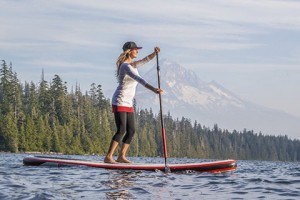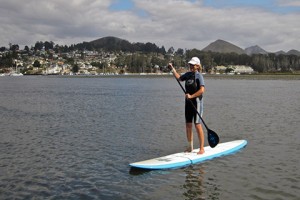 A new phenomenon in the yoga universe is called Stand Up Paddleboard yoga (called SUP yoga for short). Since SUP yoga takes place on a paddleboard in the water, it can be a bit daunting for beginning yoga students to try. But as long as you have a good grounding in balancing poses, SUP yoga is as fabulous and fun way to get out into nature and spice up your yoga routine. This short article contains six tips and poses to help newbies get more comfortable doing yoga out on the sea.
A new phenomenon in the yoga universe is called Stand Up Paddleboard yoga (called SUP yoga for short). Since SUP yoga takes place on a paddleboard in the water, it can be a bit daunting for beginning yoga students to try. But as long as you have a good grounding in balancing poses, SUP yoga is as fabulous and fun way to get out into nature and spice up your yoga routine. This short article contains six tips and poses to help newbies get more comfortable doing yoga out on the sea.
1. Know Where Your Center Is
Before getting on your board, be sure you know where the handle is located. Most of the handles on modern SUP yoga boards are in the center of the board. Not only is this central handle convenient for taking your board around, it also marks the most stable part of the whole board. Try practicing some standing poses like Warrior I or Warrior II right in the center of this board to get a sense of how this area will ground you. As you advance in your practice, you might want to try some more difficult poses like headstands. If you ever try these difficult moves, you must ensure that your body is right underneath the central handle for optimal balance.
2. Focus On The Basics
It is very often the case that people want to begin SUP yoga because they are getting tired with their normal yoga routine on land. SUP yoga will definitely offer advanced yoga practitioners a challenge, and people should expect to fail epically on moves many would consider “simple” on land. Always remember that yoga is never about competition. Rather, yoga is about working with your own body and enjoying the adventure. Perhaps one of the best lessons SUP yoga can teach even experienced yoga practitioners is the value of patience.
3. Child’s Pose and Downward-Facing Dog
These two poses are very popular in everyday yoga, and they are perfect poses to start with on your SUP yoga journey. For Child’s Pose, start with your belly button right above the center of the board, then gently bend down making sure you cradle your hips with your heels. You can either stretch your arms out in front of you on the board, or you could let your hands relax in the cool water. To get into Downward-Facing Dog, you can bring yourself out of Child’s Pose onto your knees intoTable Top and then straighten your legs as you lift up your hips. You should be looking at your knees at this point. You can hold this pose for one to two minutes.
4. Get Used To Hands And Knees
Once you get on the board, you will notice that your body naturally wants to stay lower. Many of the poses you will be working with in SUP yoga are poses lower to the ground. You should not rush into any standing poses, because they will be far too difficult if you have not mastered balancing on these lower poses. For standing poses like Warrior I, some practitioners recommend practicing on you knees and only slowly working to a standing position.
5. Slow Down
As you work on your poses on the paddleboard, you must also constantly remind yourself to move slowly. SUP yoga is great for analyzing your form, since every movement has to be done with great care and precision. Do not try to force your way into faster transitions. You should expect to be slowed down on the paddleboard. Use this slower pace as an opportunity to watch your transitions from different poses with greater attention and awareness.
6. Open Up To Environment
 One of the main reasons people love SUP yoga is because it gets you outdoors. There are many different locations you can choose to practice SUP yoga in, but it is best to find a somewhat serene area to master the basics. Wherever you go, you should always remember the importance of connection in yoga. First, connect with the present moment, your breath, and your body. After that, open your awareness to the environment and people that surround you. You should remember that this environment is far less controlled than a yoga studio, and you should try to cultivate a mind that is ready to accept the fluxes and flows of the natural world.
One of the main reasons people love SUP yoga is because it gets you outdoors. There are many different locations you can choose to practice SUP yoga in, but it is best to find a somewhat serene area to master the basics. Wherever you go, you should always remember the importance of connection in yoga. First, connect with the present moment, your breath, and your body. After that, open your awareness to the environment and people that surround you. You should remember that this environment is far less controlled than a yoga studio, and you should try to cultivate a mind that is ready to accept the fluxes and flows of the natural world.

